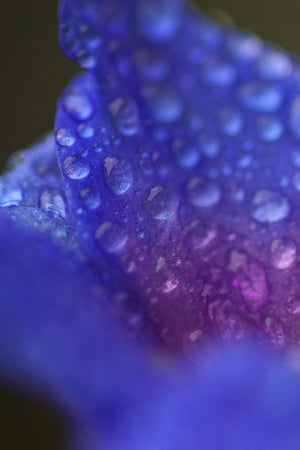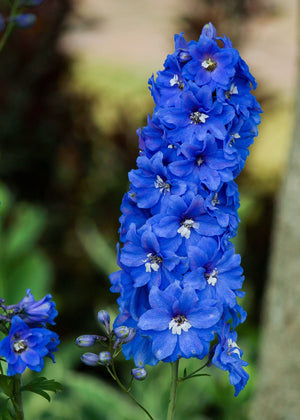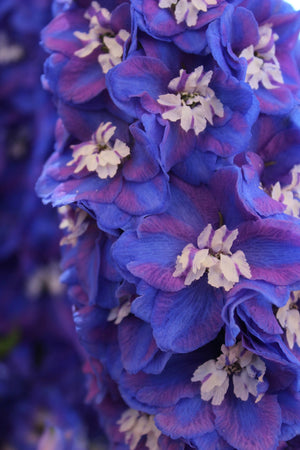The Delphinium Guide
Delphiniums are classic perennials admired for their tall spires of densely packed, colorful flowers. These elegant bloomers make a striking vertical statement in cottage gardens, mixed borders, and cutting gardens. Blooming in shades of blue, violet, pink, and white, delphiniums are favorites among pollinators and garden designers alike. With proper care, these perennials reward gardeners with breathtaking displays from late spring through summer.

About
Delphiniums belong to the Ranunculaceae family and are native to mountainous regions of the Northern Hemisphere. Known for their stately form and rich, cool-toned colors, delphiniums range in height from dwarf forms under 2 feet to towering hybrids exceeding 6 feet tall. The tall, upright spikes are adorned with numerous flowers, each with a central “bee” that adds contrast and detail.
Popular varieties include Delphinium elatum 'Aurora Blue', a tall and sturdy hybrid with vibrant cobalt blooms; 'Bellamosum', a richly saturated blue; 'Pacific Giant Summer Skies', offering soft sky-blue tones; and 'Pacific Giant Black Knight', known for its dramatic deep purple flowers. Compact types like Delphinium grandiflorum 'Summer Morning' and 'Blue Mirror' are excellent for smaller gardens and containers. The Delgenius series, including 'Shelby' and 'Neva', offers improved branching, extended bloom time, and exceptional color.
While known for their beauty, delphiniums are also notorious for their need for careful siting and care. They flourish in cool climates and require protection from wind, heavy rain, and extreme heat to perform at their best.

PLANTING
Delphiniums thrive when planted in a location that offers sun, shelter, and well-prepared soil. Proper site selection and soil preparation are key to success:
- USDA Hardiness Zones: Hardy in Zones 3–7. In warmer zones, they may struggle with heat and humidity.
- Soil: Rich, well-drained soil with high organic content. Add compost or aged manure before planting.
- Sunlight: Full sun (at least 6 hours) is ideal, though some afternoon shade may benefit them in hot climates.
- Watering: Requires regular watering, especially during dry spells. Keep soil moist but not soggy.
- Spacing: Space plants 18–24 inches apart to allow air circulation and prevent disease.
- Planting Time: Best planted in spring or fall. Mulch after planting to help retain moisture and regulate temperature.
Stake tall varieties at planting time to support flower spikes. Use bamboo stakes or peony rings to keep plants upright and prevent flopping in wind or rain.

CARE
Delphiniums are not carefree, but with consistent attention, they reward gardeners with breathtaking floral displays. Here’s how to keep them healthy and vibrant:
- Watering: Keep soil evenly moist during the growing season. Water at the base to avoid wetting the foliage.
- Fertilizing: Feed monthly during the growing season with a balanced fertilizer. High potassium encourages strong stems and blooms.
- Deadheading: Remove spent blooms to encourage a second flush of flowers later in the season.
- Staking: Tall varieties must be staked to avoid collapse during heavy bloom.
- Pests & Diseases: Monitor for slugs, aphids, and powdery mildew. Good air circulation and proper spacing help prevent disease.
- Winter Care: Cut plants back to the ground after the first frost and mulch in late fall to protect the roots in cold climates.

HOW TO USE
Delphiniums are show-stoppers in both formal and informal landscapes. Their height and vivid color make them indispensable in garden design:
- Cottage Gardens: Plant behind peonies, foxglove, or lady’s mantle for classic English garden flair.
- Mixed Borders: Use tall hybrids for back-of-border height and drama.
- Cut Flower Gardens: Long stems and rich hues make delphiniums a florist favorite.
- Pollinator Gardens: Attract bees, butterflies, and hummingbirds with their nectar-rich flowers.
- Vertical Accents: Use as living columns among shorter perennials or against a garden wall or fence.
Pair delphiniums with perennials like salvia, campanula, echinacea, coreopsis, and garden phlox. Their upright structure contrasts beautifully with mounded or spreading plants.

COMMON QUESTIONS
- Are delphiniums perennials? Yes, delphiniums are perennials, though they may be short-lived in hot or humid climates.
- Are delphiniums poisonous? Yes, all parts of the plant are toxic if ingested and can cause skin irritation.
- Are delphiniums tall? Many varieties are tall, growing 3–6 feet or more, though dwarf and medium-height forms exist.
- How to grow delphiniums? Plant in rich, well-drained soil in full sun. Provide regular water and support for tall varieties.
- Do deer eat delphiniums? Deer typically avoid delphiniums due to their toxicity.
- When do delphiniums bloom? Most bloom from late spring to early summer, with a possible second bloom in late summer if deadheaded.
- Are delphiniums deer resistant? Yes, they are considered deer resistant.
- Are delphiniums poisonous to dogs? Yes, delphiniums are toxic to dogs and should be kept out of reach.
- Are delphiniums poisonous to cats? Yes, they are also toxic to cats.
- Do delphiniums self seed? Yes, some delphiniums will self-seed under the right conditions, but hybrid varieties may not come true from seed.
Conclusion
Delphiniums bring vertical elegance and cool-toned color to the garden like no other perennial. Whether you choose classic tall varieties like 'Black Knight' or compact selections like 'Blue Mirror', delphiniums add a regal quality to borders and floral arrangements. With a little care and attention, these striking plants reward you with unforgettable blooms that elevate the garden season after season.
The Delphinium Collection
Sold Out
Sold Out
Sold Out
Sold Out
Sold Out






